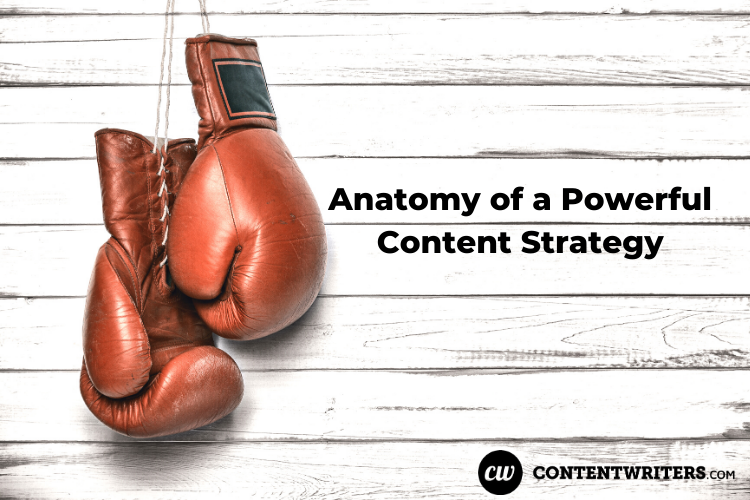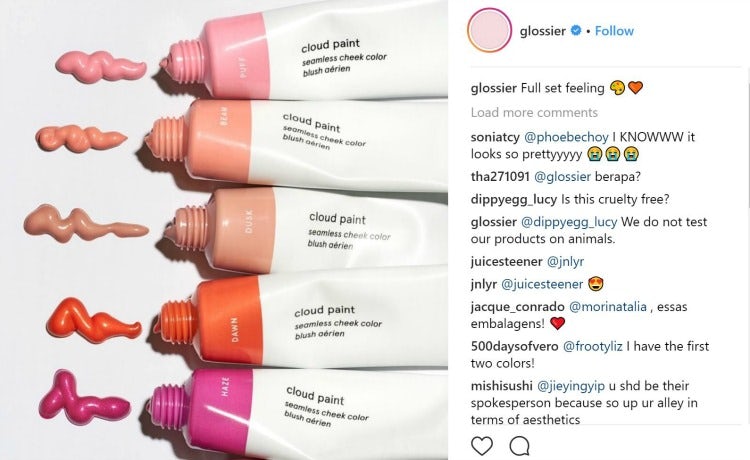
Anatomy of a Powerful Content Strategy
Not so long ago, you could post two 400-word articles per week and be a leader in content strategy.
Those days are gone.
Today, if you want great content marketing — the kind that delivers sky-high ROI — you’ve got to build a powerful, competitor-crushing strategy.
It’s a little daunting, but it is possible. This article includes everything you need to get your content strategy going in the right direction.
What Is Content Strategy?
Real quick, let’s get on the same page about this.
Content Strategy Definition
Your content strategy is a high-level framework for making decisions about your content. Ideally, the framework is rooted in your goals and values. Then, once you’ve shaped that framework, you’ll use it to plan, produce, and distribute content.
There’s one common point of confusion to clear up: A strategy is NOT the same thing as a content calendar. A calendar is a tactical thing — it should be developed based on your bigger-picture strategy. If you find that your specific publishing schedule isn’t serving your goals, you can change it while still following the same overall strategy.

The Big Questions of Content Strategy
When you have a solid content strategy, you can answer the big questions that are vital to producing highly effective content. Here are the most crucial ones:
- Why am I creating content?
- What goal(s) should my content help me reach?
- Who is my content geared toward?
- How do I want my audience to respond to my content?
- Where (on which platforms) will I distribute my content?
Once you’ve answered these questions, you’ll apply the same answers again and again. This makes the decision-making process much easier when it comes time to brainstorm, create, distribute, and measure the ROI of content.
Your Content is a Body of Work
Before you can build a content strategy, it’s important to understand one thing: This strategy will shape your entire body of work.
Your body of work is not only your blog, but also your emails, videos, podcasts, social media posts, keynote speeches, and so on. This body of content represents you (or your brand) online.
So, what does it take to make that representation powerful? It starts with the DNA.

The DNA: Who You Are
One of the most obvious signs of a poor (or absent) content strategy is a lack of cohesion. The content seems fragmented. It doesn’t emphasize any particular central themes in any way.
To fix this, you need to start by going back to the building blocks of your personality or brand. In other words, you need to define who you are.
Whether you’re an individual or a company, your content should express your unique identity. If you don’t know what your identity is, you can’t express it. Before you go any further with content strategy or creation, answer these questions:
- What’s my distinctive personality (or brand persona)?
- What’s my unique selling proposition?
- What are my core values?
- What kind of conversations do I want to have with other people?
- What kind of people do I want to connect with?
The answers to these questions will help you figure out which content actually fits your personality. They’ll also help you determine which platforms are appropriate and which aren’t a good fit. Be sure to answer these questions before moving forward with your strategy.
Example: Dan Lok, the Asian Dragon
Millionaire sales guru Dan Lok has done an exemplary job of this. His content — including social media, YouTube, his blog, and books—is utterly unified around his Asian Dragon persona. Lok made the decision to own that persona, committing to it 100% — and that decision is paying off.
The Skeleton: Your Goals
Great content is purposeful. To publish with confidence, you need to set concrete goals, then fit your content to those goals.
Let’s say, for example, you wrote a cookbook, and you want to use digital content to sell copies. Even if you’re also a movie buff, movie reviews shouldn’t take center stage within your content strategy. Pictures and articles about food are going to deliver more value.
To form the skeleton of your content strategy, you first need to answer two questions.
- What one big goal do I most deeply want to accomplish with my content?
- What smaller goals (or milestones) are essential to accomplish that?
Once you have the answer to these questions, you can make decisions about which content to release at what time. Hubspot has a good guide for mapping different types of content to different stages of the sales funnel.

Example: Glossier
One brand that has excelled at setting goals leading to a super-crisp content strategy is Glossier. This digitally native beauty brand has the broader goal of having customers, especially loyal customers, to promote the products to their friends.
Glossier’s corresponding content strategy is fundamentally conversational. Almost all of the content that the brand produces and distributes is directly intended to spark conversations on social media, especially Instagram. Glossier also distributes a good amount of user-generated content as part of its content strategy. Through this laser focus on stirring up conversation, Glossier has created a powerful ecosystem of shared customer experiences.
The Muscle: Your Core Topics and Expertise
Once you have your DNA and skeleton (your identity and goals), it’s time to decide which topics will do the “heavy lifting.”
Every good content strategy is centered around a small number of core topics. Within the overall strategy, each piece of content explores those same topics from different angles. Since most people need to encounter ideas more than once in order to remember them, you need to introduce the same ideas to your audience repeatedly. For individual bloggers, David Perell (“the writing guy”) calls this building a personal monopoly—but brands can learn from his approach, too.
These questions will help you build the muscle of your content:
- What do I know more about than other people? (Or, what is my brand’s core competency?)
- What am I really great at explaining?
- What unusual or unique experiences can I share?
While it can be tempting to pour your entire life and all your experiences into the content, this can create a chaotic, unfocused image of your brand. Instead of publishing something about every small idea, it’s better to tie your smaller ideas into content that focuses on a few bigger ones.

Example: Ryan Holiday of Daily Stoic
Former media strategist turned author-entrepreneur Ryan Holiday has built an ingenious personal monopoly. With his website, Daily Stoic, and his corresponding books, he’s making the ancient philosophy of Stoicism accessible to modern readers. Due to his laser focus on this family of ideas, he’s earned his place as the most sought-after authority on these topics.
The Voice and Style: How Your Content Looks, Feels, and Sounds
Once you have a solid grasp of your DNA, your goals, and the core concepts that will do the heavy lifting, it’s time to determine your voice and style.
On a high level, voice and style are part of your strategy. Although you can make adjustments to it, think of your style guide as a strategic document that doesn’t change-unless you modify it. Without a clear, consistent voice and style, your content will lack impact. Even if your style isn’t 100% perfect, the consistency will make a big difference. Continuity is the key.
While voice and style should stem from the DNA already established, you also need to research your competitors and examine the high-performing content. This will help generate creative stylistic ideas that resonate with other people.
Great Style on a Small Budget
When I work with people to define a style for their content, they sometimes start out feeling discouraged. They look at brands like Red Bull and think, “There’s no way I can host a supersonic free-fall from 128,100 feet above the earth’s surface.”
And yeah, if you’re not Red Bull, you probably don’t have the budget for a stunt like that. However, style is not about stunts.
With some thought, you can do stylish things with words and images alone. Take Rick Beato, for example. His YouTube series, called “What Makes This Song Great?”, showcases his expertise with a catchy, consistent, playful style — and it’s all based on five words.
Approach your voice and style strategically and you can have a solid, professional, attention-grabbing style on any budget. You just need to lay the groundwork first — the DNA, the skeleton, and the muscle—and then you can move on to the style.
The Habitat: Where Your Content is Most at Home
Finally, at the same time you determine your style, it’s also the time to decide where your content will primarily “live.” This is important because the habitat will shape the format and publishing cadence of your content. If you’re making a boatload of square-shaped images but only posting them to a WordPress blog, you’re missing a golden opportunity to get eyeballs on Instagram. Explore the capabilities of each platform and use the platform that makes the most sense for your brand.
Heads up! If you try to engage customers on too many platforms, your content strategy will fall apart.
Even though there are several platforms to distribute content, the best content creators don’t build a separate strategy for each one. Instead, they focus on one or two platforms where they’re strongest; the weaker platforms are used to drive traffic toward the stronger ones. It’s better to master one platform than be a jack-of-all-platforms and master of none.
So, if you want to focus on YouTube, do that — and make your blog a vehicle for driving YouTube engagement. If you want to focus on your blog, great: you can then add Twitter not as a separate initiative, but as a way to drive traffic to your blog.

Be Fruitful and Multiply
By the end of this process, you should have the following five components of your content strategy.
- The DNA: An understanding of your (or your brand’s) identity, core values, and what kind of people are suited to that identity.
- The Skeleton: The goals of your content.
- The Muscle: The core ideas, topics, and expertise your content will contain.
- The Voice and Style: The clear, consistent presentation you’re going to use for your content.
- The Habitat: The platforms you’re going to focus on to distribute your content.
These five components compose your content strategy—your high-level framework for making decisions about your content.
From here, it’s all tactics—the specific actions you take according to this framework. If you’ve done your work well, these five components now express all the principles and “rules of thumb” you need to make those tactical decisions. Those decisions include which content to produce, when, and how often.
Executing any strategy takes trial and error, even for the most experienced marketers. Don’t let that bring you down. Use A/B testing to see how if the content you’re producing is serving your business goals. If a piece of content flopped, move on and produce another one.
Ultimately, having a powerful body of work is all about producing content that’s aligned with the same decision-making framework. Keep putting the pieces together, and you’ll see the results.
Ellen F. has eight years of experience writing and editing B2B and B2C content for a range of industries, including medicine, education, digital marketing, law, sports/outdoors, and management consulting. She has a particular knack for captivating SMB business owners with B2B content and marketing copy.




